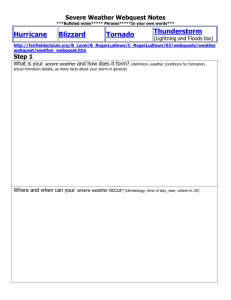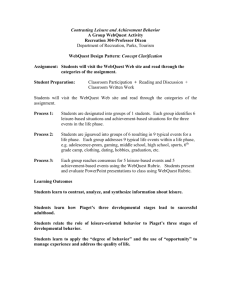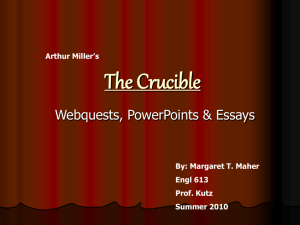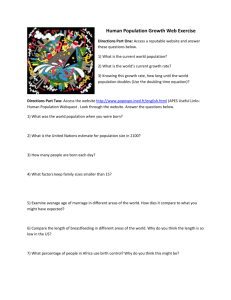lesson plan 2 - SuttonTechnologyPortfolioED508
advertisement
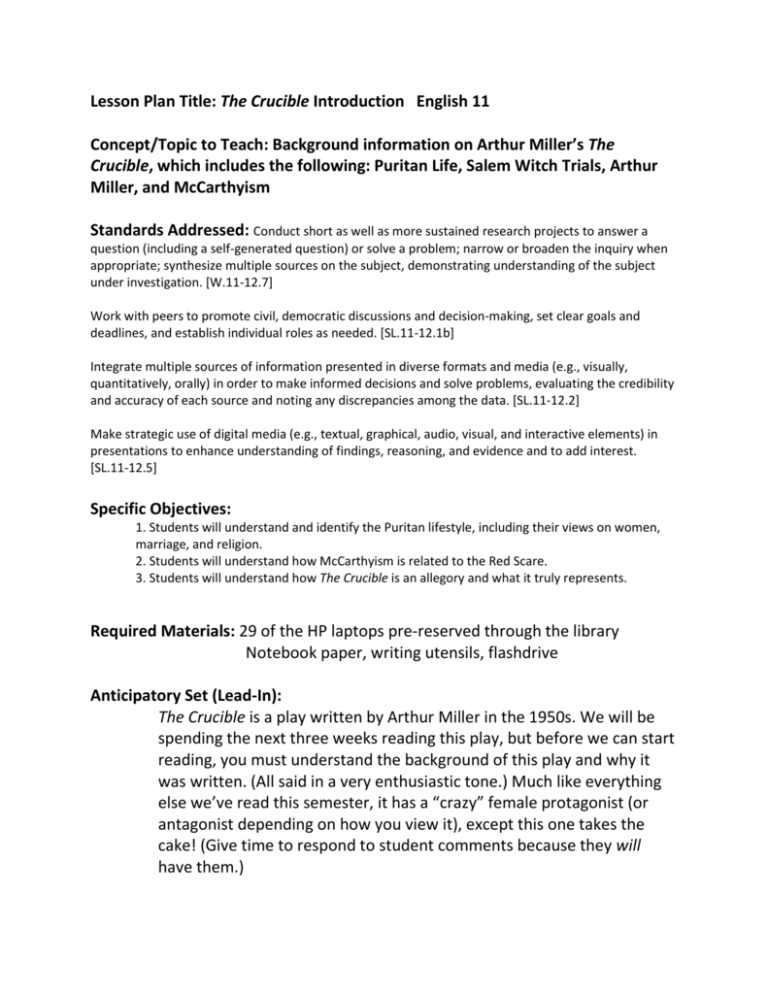
Lesson Plan Title: The Crucible Introduction English 11 Concept/Topic to Teach: Background information on Arthur Miller’s The Crucible, which includes the following: Puritan Life, Salem Witch Trials, Arthur Miller, and McCarthyism Standards Addressed: Conduct short as well as more sustained research projects to answer a question (including a self-generated question) or solve a problem; narrow or broaden the inquiry when appropriate; synthesize multiple sources on the subject, demonstrating understanding of the subject under investigation. [W.11-12.7] Work with peers to promote civil, democratic discussions and decision-making, set clear goals and deadlines, and establish individual roles as needed. [SL.11-12.1b] Integrate multiple sources of information presented in diverse formats and media (e.g., visually, quantitatively, orally) in order to make informed decisions and solve problems, evaluating the credibility and accuracy of each source and noting any discrepancies among the data. [SL.11-12.2] Make strategic use of digital media (e.g., textual, graphical, audio, visual, and interactive elements) in presentations to enhance understanding of findings, reasoning, and evidence and to add interest. [SL.11-12.5] Specific Objectives: 1. Students will understand and identify the Puritan lifestyle, including their views on women, marriage, and religion. 2. Students will understand how McCarthyism is related to the Red Scare. 3. Students will understand how The Crucible is an allegory and what it truly represents. Required Materials: 29 of the HP laptops pre-reserved through the library Notebook paper, writing utensils, flashdrive Anticipatory Set (Lead-In): The Crucible is a play written by Arthur Miller in the 1950s. We will be spending the next three weeks reading this play, but before we can start reading, you must understand the background of this play and why it was written. (All said in a very enthusiastic tone.) Much like everything else we’ve read this semester, it has a “crazy” female protagonist (or antagonist depending on how you view it), except this one takes the cake! (Give time to respond to student comments because they will have them.) Also, can someone explain to me what a “sub-tweet” is? (The kids will jump to answer as they all have a twitter account.) Once someone answers, explain to the class how The Crucible is an allegory, which is basically just like a sub-tweet (meaning one thing on the outside but really meaning something completely different on the inside) Step-By-Step Procedures for Teaching the Lesson: Day 1: Students will be divided into groups of 4. They can choose their own groups. I will tell students that as group they will be creating a webquest on the background of The Crucible. Each person in the group will be assigned a certain topic (Puritan Life, Salem Witch Trials, Arthur Miller, and McCarthyism). Each student will conduct research on their assigned topic and create their own part of the group’s webquest at the end of the week. Once all webquests are completed, each student will complete another group’s webquest. Once students are in their groups, I will pass out guided research questions for each topic that students will answer as they are conducting research on their chosen topic. Students can decide between one another about which topic they want to complete. Students will begin their research once I have gone over all the instructions for the project and passed out the project guidelines/grading rubric. I will also discuss how each student is responsible for their own work, and even though this is a group project, no one person should be “taking over” the group because everyone has an equal part that they must complete. They will be graded on their individual work and how they all come together in the end to create their group webquest. Students will complete as much as they can of the guided research questions on their specific topic. They will have today and tomorrow to complete this. Day 2: Students will continue their research from yesterday on the given topic relating to the background of The Crucible. They will answer all the questions that they have to answer on their topic. They will turn these in when they are done. This formative assessment will count towards their individual grade for the group project. I will grade these answers tonight and give them back to each student the next day. Day 3 and 4 (block day): Students will refer to the project guideline sheet I passed out to them on Monday. I will pass back the answers to their guided research questions so they can use them as a resource. Each person in the group will create their own part of the webquest, following the project requirements on the guideline sheet. Each part of the webquest needs to contain 4 different websites with 5 questions to be answered under each site. Each student will need to create a Word document that includes their websites and questions. Students will complete their portion of the webquest. Once they have fulfilled all the requirements on the project guideline sheet, all group members need to email their portion of the webquest to one person in the group. Once they have done this, they all need to work together into putting all 4 parts into one document, creating one webquest. Once they have done this, they will e-mail their created webquest to me. Day 5: I will print out and pass back each group’s webquest to another group. They will work together to complete another group’s webquest. They each will turn in a sheet of paper with their own answers, even though they will be working together on this. This will be taken up for a separate grade. Also, each student in the group will complete the group assessment for each of their group members. These will be confidential and only seen by me. Guided Practice/Monitoring: Students will answer the guided research questions as they are conducting research on their topic. I will walk around and make sure students are staying on task while answering any questions they may have. Closure (Reflect Anticipatory Set): The following Monday we will have a class discussion on all four parts of the webquest. I will explain how The Crucible is an allegory and what is truly represented. Students will understand the research that they did and how it relate to The Crucible. Assessment Based on Objectives: 1. Students will understand and identify the Puritan lifestyle, including their views on women, marriage, and religion with 80 percent accuracy. 2. Students will understand how McCarthyism is related to the Red Scare by being able to write about the relationship. 3. Students will understand how The Crucible is an allegory and what it truly represents by being able to explain its true meaning through an essay. Adaptations (For Students With Special Needs): Students with learning disabilities will be able to complete this project with the special education teacher in their classroom. They will have to use 3 websites instead of 4, with 4 questions for each site instead of 5. Extensions (For Advanced Students): Gifted students will complete this project along with a written response that they will write after they have finished another group’s webquest. The response will be about the relationship between the topic they did research on and the topic they completed the webquest on. Possible Connections to Other Subjects: History-McCarthyism, the Red Scare Reflection: I have not taught this lesson yet, but in the past I would have not incorporated this project into a group project because I did not have the resources. Students would have gone to the computer lab where all computers may or may not have worked, and they would have completed a webquest on the same topic that I found online. Incorporating this into a group project is effective because it will hold each student accountable, and will hopefully push students who do not always do their work to complete it since other people rely on them. By every student having an accessible laptop, they will be more engaged and eager to do their work. And, I’ve always said that students will truly learn something if you ask them to teach it. This is similar because they are spending a lot of time on a given topic, so I anticipate that every student will learn something that will stick with them for a while on this topic. Guided Research Questions for The Crucible Webquest Directions: Once you have talked with your group members and decided on topics, you must conduct research on your chosen topic and answer the following guided research questions. You will be turning this in for a grade. Puritan Life 1. 2. 3. 4. 5. 6. 7. 8. Who were the Puritans? What distinguished their faith from others of their time period? Why did they cross the Atlantic Ocean? What were their goals? Give several examples of typical Puritan beliefs. In particular, how did Puritans feel about the Sabbath day? What were the focal points of Puritan life? What was the dominant motivating force in Puritan society (especially in "Sinners in the Hands of an Angry God"? 9. What sort activities were and were not acceptable to the Puritans as recreation? 10. How tolerant were the Puritans of those who differed from their norms? Salem Witch Trials 1. What were some beliefs about witchcraft and witches people held in the past? 2. What were the Salem witchcraft trials? 3. What are some possible explanations for the Salem witchcraft trials? 4. What options did an accused witch have in Salem? 5. How quickly did things get out of hand in Salem? 6. How long did the Salem witchcraft trials go on for? 7. What sort of evidence was used to arrest accused witches? 8. Do "witch hunts" still happen? 9. Can you think of anything else that has happened in this country that would also be considered a "witch hunt"? Arthur Miller 1. What major historical event shaped Arthur Miller's childhood? 2. What happened when Miller was called before the House Un-American Activities Committee? 3. To whom was Miller married? 4. What sort of awards did Miller receive? 5. Describe the common themes of Miller's writings (pay particular attention to any references to The Crucible). 6. How would you categorize Arthur Miller's political views? 7. How do you think Miller viewed the function of drama? McCarthyism 1. What was McCarthyism, or The Second Red Scare? 2. Who was the target of this movement? 3. Who was Joseph McCarthy? 4. Why do you think McCarthy began persecuting Communists? 5. What eventually became of Joseph McCarthy? 6. How was the persecution of McCarthyism carried out? 7. What happened to people who were Blacklisted by the HUAC? 8. What options did people called before the HUAC have? 9. What were the consequences of each course of action? The Crucible Webquest Project Project Description You will work with your group to create a webquest on the background information of The Crucible. Even though this is a group project, you will be working individually and creating one group product in the end. You will conduct individual research and create your own portion of the webquest. Once this is complete, you will work with your group to put all of your portions together to create one complete webquest. At the end of the week, you will complete another group’s webquest. *You will be graded individually, so a group member’s lack of work will not affect your grade in the end. This is a 100 point project. Day 1 You will put yourself into a group of 4. Make sure you are working with students whom you can rely on as this is a GROUP project. You each will be given a laptop to conduct research on a given topic relating to the background information of The Crucible. You will INDIVIDUALLY be conducting research; that means no two people in the same group will be researching the same topic. You may choose from one of the following topics: Puritan life, Salem Witch Trials, Arthur Miller, or McCarthyism. Once you have decided on your topic, you may begin your research. If you are absent, it is your responsibility to make up any work missed. Remember, your group is relying on you, so it is important that you are completing your part of the project. Day 2 You will complete your research that you started yesterday. All answers to the guided research questions should be turned in to me at the end of the class period. Remember, if you are absent it is your responsibility to make up your missed work. Day 3 and 4 (block day) You will use the entire period to create your portion of the webquest on the topic you have researched. I will pass back your guided research questions for you to use as a resource. Now that you are familiar with your topic, you should be able to recall websites that were helpful in your research. The guidelines for the webquest are as follows: o Each part of the webquest needs to contain 4 different websites with 5 questions to be answered under each site. Each student will need to create a Word document that includes their websites and questions. Make sure you save your work on a flashdrive or e-mail it to yourself so you do not lose it. o The questions need to be detailed enough to where the answer should not be one word. The questions need to be worded to where there is thought involved and each answer should be 2-3 sentences in length, not one word answers. o You may not use the questions I provided for your guided research questions. You may use them as a guide, but you may not use them verbatim. When every group member is finished creating their portion of the webquest, you need to decide who to e-mail them all to. All portions of the webquest need to be put into ONE DOCUMENT and it should be neat and attractive. You will work together on this part, but you must decide one person to send all of your work to. THIS SHOULD BE EMAILED TO ME BY THE END OF THE PERIOD WITH ALL YOUR NAMES ON IT. Day 5 I will hand each group a different group’s webquest. Each group member will complete a different portion of the webquest that they did not research themselves. Note: no two group members will be completing the same portion of another group’s webquest. All answers will be due at the end of the period. Group members will also assess their group members through a confidential survey. They do not have to put their names on them, but they will have to turn one in assessing each member in their group’s work ethic and if they think they did good job/what grade they think they deserve. Directions: Use this graphic organizer to help you organize your thoughts for information on your topic. Who: How: What: Topic: Why: When: Where: Multimedia Project : The Crucible Webquest Project: Group Assessment Directions: You will grade each group member’s work on their portion of the webquest. Be honest with your grading. No one will see this but me. Also, answer the questions on the back relating to your groupmates’ work. Student Name: CATEGORY Sources ________________________________________ 20 Four sources are used in the webquest. Source information collected for all questions. All documented in desired format. There are 5 higher order thinking questions listed under each website. 16 Three sources are used in the webquest. Source information collected for all questions. Most documented in desired format. There are 4 higher order thinking questions listed under each website. Originality Product shows a large amount of original thought. Ideas are creative and inventive. Product shows some original thought. Work shows new ideas and insights. Mechanics No misspellings or grammatical errors. Organization Content is well organized using headings or bulleted lists to group related material. Requirements 10 Two sources are used in the webquest. Source information collected for all questions, but not documented in desired format. There are 3 higher order thinking questions listed under each website. 8 1 source is used in the webquest. Very little or no source information was collected. There are 2 or less higher order thinking questions listed under each website. Uses other people's ideas (giving them credit), but there is little evidence of original thinking. Three or fewer Four misspellings misspellings and/or and/or mechanical errors. grammatical errors. Uses other people's ideas, but does not give them credit. Uses headings or bulleted lists to organize, but the overall organization of There was no clear or logical organizational structure, just lots of facts. Content is logically organized for the most part. More than 4 errors in spelling or grammar. topics appears flawed. Group Survey 1. Do you think this person put in as much effort as they could? 2. Do you think their webquest questions covered all the criteria I was asking for? 3. Without using the rubric, what grade would you have given them for their work? Please add any other comments you may have. Multimedia Project : The Crucible Webquest Project Student Name: CATEGORY Sources ________________________________________ 20 Four sources are used in the webquest. Source information collected for all questions. All documented in desired format. There are 5 higher order thinking questions listed under each website. 16 Three sources are used in the webquest. Source information collected for all questions. Most documented in desired format. There are 4 higher order thinking questions listed under each website. Originality Product shows a large amount of original thought. Ideas are creative and inventive. Product shows some original thought. Work shows new ideas and insights. Mechanics No misspellings or grammatical errors. Organization Content is well organized using headings or bulleted lists to group related material. Requirements 10 Two sources are used in the webquest. Source information collected for all questions, but not documented in desired format. There are 3 higher order thinking questions listed under each website. 8 1 source is used in the webquest. Very little or no source information was collected. There are 2 or less higher order thinking questions listed under each website. Uses other people's ideas (giving them credit), but there is little evidence of original thinking. Three or fewer Four misspellings misspellings and/or and/or mechanical errors. grammatical errors. Uses other people's ideas, but does not give them credit. Uses headings or bulleted lists to organize, but the overall organization of topics appears flawed. There was no clear or logical organizational structure, just lots of facts. Content is logically organized for the most part. More than 4 errors in spelling or grammar. NETS-S Checklist 1. Apply existing knowledge to generate new ideas, products, or processes. 2. Interact, collaborate, and publish with peers, experts, or others employing a variety of digital environments and media. 3. Evaluate and select information sources and digital tools based on the appropriateness to specific tasks. 4. Exhibit a positive attitude toward using technology that supports collaboration, learning, and productivity. 5. Select and use applications effectively and productively.
